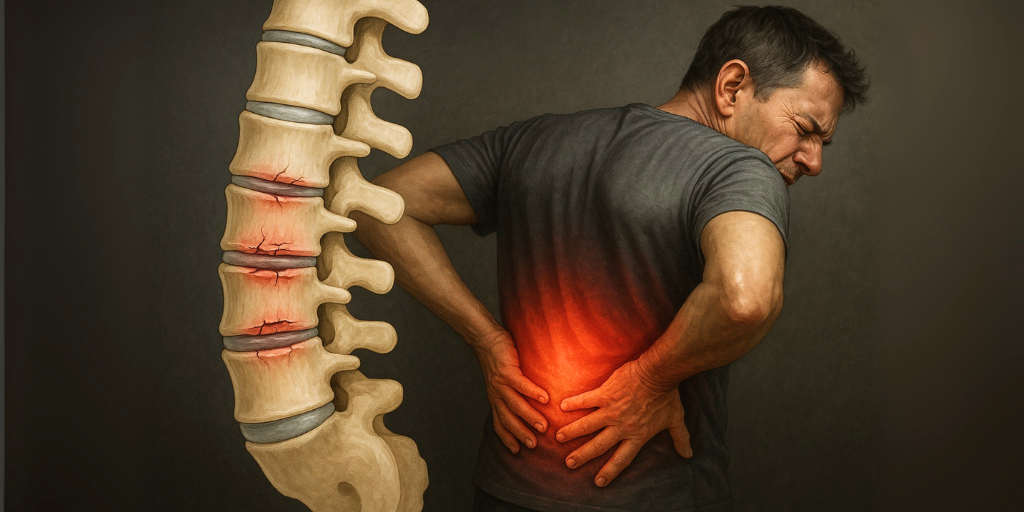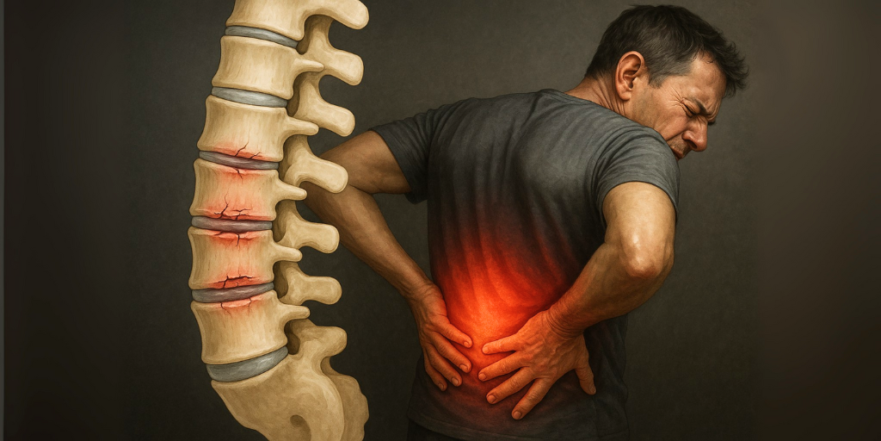
What if I told you that being diagnosed with osteopenia is like being told you’re “a little bit pregnant”? It sounds funny, but there’s a crucial truth here. Medically, we draw a line between osteopenia (lower-than-normal bone density) and osteoporosis (severely low bone density), but the underlying process causing the bone loss is exactly the same. You’re either losing bone, or you’re not. Today, we’re going to talk about the often-silent symptoms of this bone loss and, more importantly, what you can actually do about it, based on decades of clinical experience.
Sadly, both osteopenia and osteoporosis are often completely asymptomatic until something breaks. This is why it’s called a silent disease. You can be walking around with weakening bones and have no idea until a minor trip or a simple twist results in a fracture. This article will guide you through the subtle signs to watch for, debunk some common myths, and reveal the surprising root cause that your doctor might not be talking about. The goal is to empower you with knowledge so you can take control of your bone health, rather than just waiting for a diagnosis or a fracture. (Based on the insights of Dr. Gundry.)
Key Takeaways
- Osteopenia and osteoporosis are the same condition on a spectrum of bone loss. The underlying cause is identical.
- Symptoms are often absent until a fracture occurs. When they do appear, they can include fractures from minor events, loss of height, stooped posture, and persistent back pain.
- Modern diagnosis is flawed. DEXA scans compare your bone density to that of a healthy 30-year-old, which is an unrealistic standard for most people and has created an industry around diagnosing and treating a condition that might be a normal part of aging.
- Conventional bone-building drugs have serious risks. They can create bone that is dense but brittle, leading to a risk of spontaneous fractures. Many dental surgeons refuse to operate on patients taking these drugs.
- The root cause is often your diet. Leaky gut, caused by inflammatory foods, is a primary driver of the inflammation that leads to bone loss. Reversing bone loss is possible by changing what you eat.
1. The “Silent” Symptoms You Can’t Ignore
Because bone loss happens quietly over many years, you often don’t feel it. However, there are several red flags that should prompt a conversation with your healthcare provider. The most obvious sign is a fracture that occurs much more easily than you’d expect. This isn’t a break from a major car accident; this is a fracture from a simple fall, tripping over a curb, or even just twisting your back in a funny way. We see patients who develop a vertebral compression fracture—where one of the small bones in your spine collapses—from something as simple as a sneeze or lifting a bag of groceries. Sometimes, you might be chewing on something and feel a sudden, sharp pain in your jaw, thinking you’ve cracked a tooth when you’ve actually fractured your jawbone.
Beyond fractures, persistent and chronic back pain should be investigated. While back pain is common, pain that doesn’t go away could be a sign of these tiny, undetected compression fractures in your spine. Another tell-tale sign is a gradual loss of height. We all tend to get a little shorter as we age, but a noticeable reduction in height often comes from the spine compressing due to weakened vertebrae. This can also lead to a stooped posture, sometimes called a “dowager’s hump,” which is a visible curvature in the upper back. While less common, some people may experience a general sense of bone discomfort or tenderness, but this is far less frequent than the other signs.
2. Debunking Common Misconceptions About Symptoms
If you search online for symptoms of osteoporosis, you’ll find a host of other associated conditions that are, frankly, misleading. Let’s clear a few of these up. For instance, chronic fatigue is often listed as a symptom. In my 25 years of practice, I have never seen chronic fatigue as a direct symptom of osteoporosis. The truth is, the underlying issues that cause chronic fatigue (like inflammation and poor nutrition) are the same things that cause osteoporosis, but one does not cause the other.
Similarly, you might read that balance problems are a symptom. Again, this isn’t directly true. Weakened bones themselves don’t affect your coordination. However, a compressed vertebra can lead to spinal stenosis (a narrowing of the spinal canal), which can cause balance issues. Another myth is muscle weakness. This is a classic case of confusing cause and effect. Your bone density is heavily dependent on your muscles actively pulling on your bones through exercise. If you aren’t using your muscles, they become weak, and your bones lose density as a result. So, muscle weakness isn’t a symptom of osteoporosis; a lack of muscle use is a cause of osteoporosis.
3. How Bone Loss is Diagnosed (And Why It’s Flawed)
So, how did you get told you have osteopenia or osteoporosis in the first place? Most likely, it was from a DEXA scan, a machine that measures bone density. The invention of this machine created an entire new medical industry. Suddenly, we had a tool to measure bone density, and around the same time, a new class of pharmaceutical drugs was developed to increase it. It was a match made in heaven for the pharmaceutical industry: a machine to diagnose a problem and a drug to treat it.
But here’s the problem: your bone density score is almost always compared to the bone density of a healthy 30-year-old woman. This is the “gold standard.” But what if you’re 50, 60, or 80? Of course your bones aren’t going to be as dense as a 30-year-old’s! We don’t have a standard for what an 80-year-old’s bones are supposed to look like. By comparing everyone to this youthful ideal, we’ve created a “paper tiger”—an artificial problem—that makes it seem like millions of people have a disease that needs treatment. It’s no wonder so many people are diagnosed with osteopenia based on this modern, but flawed, technology.
4. The Dangers of Conventional Bone-Building Drugs
When you get this diagnosis, the next step is often a prescription for a bone-building drug. To understand why this is risky, you need to know a little about your bone cells. You have osteoblasts, which build new bone, and osteoclasts, which are like little Pac-Man cells that go around eating up old bone. This is a constant, healthy remodeling process.
These drugs work by telling the osteoclasts—the Pac-Man cells—to stop working. As a result, the osteoblasts keep building bone without the old bone being cleared away. Your bone density score on a DEXA scan goes up, and the problem seems solved. But it’s not. This delicate balance between bone formation and destruction exists for a very good reason. The new bone that is formed without the proper remodeling process is dense, but it’s also incredibly brittle. The warning labels on these drugs even list “sudden fracture” as a side effect. I have personally had patients who, while standing perfectly still, spontaneously fractured their hip. Others have fractured their jaw while chewing. In fact, most dental implant surgeons will refuse to perform an implant on a woman who is on these drugs, and they will wait at least six months after she stops taking them. Doesn’t that seem strange? If the drugs make bones stronger, wouldn’t that be the perfect time for an implant? The reality is that dentists know this bone is weaker and won’t hold the implant.
5. The Surprising Root Cause: Your Gut Health
The evidence is becoming overwhelmingly clear that the primary cause of osteoporosis for many people is not a lack of calcium or a drug deficiency; it’s leaky gut. When the lining of your gut becomes permeable, inflammatory particles called lipopolysaccharides (LPS), which are fragments of bacteria, can leak into your bloodstream. Your immune system sees these particles as foreign invaders and launches an inflammatory attack. This chronic, low-grade inflammation is a major driver of bone loss. The same inflammatory signals that damage your joints and arteries also tell your body to break down bone.
This explains why simply taking calcium supplements or bone-building drugs often fails to address the root of the problem. You’re trying to patch a hole in a sinking ship without addressing the leak. Until you heal the gut and stop the constant stream of inflammation, your body will continue to be in a state that promotes bone destruction over bone formation. The key to truly strong, resilient bones isn’t found in a pill; it’s found in your gut.
6. A Real-Life Example of Reversal
Let me tell you a story. I once had a patient, a marathon runner in her mid-40s, who was diagnosed with severe osteoporosis. Can you imagine? A highly active woman who even used weighted backpacks during her runs had weak bones. You might assume the running was the problem, but you’d be wrong. Years later, this woman is now in her mid-70s, and she no longer has osteoporosis. She also no longer runs marathons.
So, what changed? It wasn’t stopping the running that fixed her bones; it was changing her diet. As a marathon runner, she was a complete “carboholic.” Her diet consisted almost entirely of popcorn, potato chips, corn chips, and pasta. This diet was fueling a massive amount of inflammation and causing a severe case of leaky gut. When we removed those foods and put her on a diet designed to heal the gut (the Plant Paradox diet), her leaky gut sealed, the inflammation subsided, and miraculously, her osteoporosis went away. How do I know this story so well? That woman was my wife, Penny. Seeing this transformation in my own family, and countless times since in my patients, has proven to me that the reversal of osteopenia and osteoporosis is all about what you eat.
7. What You Can Do Today: It Starts With Your Diet
The lesson from Penny’s story is a powerful one for everyone. Your bone health is inextricably linked to your diet. If you’ve been diagnosed with osteopenia or osteoporosis, the most powerful step you can take is to look at your plate. The focus should be on eliminating the foods that cause leaky gut and inflammation. This means cutting out processed grains, sugars, and lectin-heavy foods like corn, pasta, and chips—the very diet that was destroying my wife’s bones.
Instead, focus on a diet rich in leafy greens, colorful vegetables, healthy fats like olive oil and avocados, and high-quality protein. These foods provide the nutrients your body needs to fight inflammation and build strong, healthy bone tissue from the inside out. It’s not about taking a drug to manipulate one part of the bone-remodeling process; it’s about creating an internal environment where your body can heal itself and maintain its natural, healthy balance. The power to build stronger bones is not in the pharmacy—it’s in your kitchen.
Conclusion
Receiving a diagnosis of osteopenia or osteoporosis can be frightening, but it doesn’t have to be a life sentence of worrying about fractures or taking risky medications. Understand that this diagnosis is often based on a flawed standard and that the conventional treatments may cause more harm than good. The real path to stronger, healthier bones lies in addressing the root cause. By focusing on healing your gut and adopting an anti-inflammatory diet, you can halt bone loss and even begin to reverse it. You have more control over your bone health than you’ve been led to believe, and it all starts with your very next meal.
Source: Dr. Gundry

